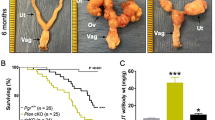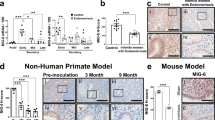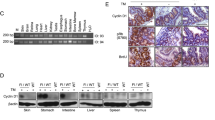Abstract
Ablation of Mig-6 in the murine uterus leads to the development of endometrial hyperplasia and estrogen-induced endometrial cancer. An additional endometrial cancer mouse model is generated by the ablation of phosphatase and tensin homolog deleted from chromosome 10 (Pten) (either as heterozygotes or by conditional uterine ablation). To determine the interplay between Mig-6 and the PTEN/phosphoinositide 3-kinase signaling pathway during endometrial tumorigenesis, we generated mice with Mig-6 and Pten conditionally ablated in progesterone receptor-positive cells (PRcre/+Mig-6f/fPtenf/f; Mig-6d/dPtend/d). The ablation of both Mig-6 and Pten dramatically accelerated the development of endometrial cancer compared with the single ablation of either gene. The epithelium of Mig-6d/dPtend/d mice showed a significant decrease in the number of apoptotic cells compared with Ptend/d mice. The expression of the estrogen-induced apoptotic inhibitors Birc1 was significantly increased in Mig-6d/dPtend/d mice. We identified extracellular signal-regulated kinase 2 (ERK2) as an MIG-6 interacting protein by coimmunoprecipitation and demonstrated that the level of ERK2 phosphorylation was increased upon Mig-6 ablation either singly or in combination with Pten ablation. These results suggest that Mig-6 exerts a tumor-suppressor function in endometrial cancer by promoting epithelial cell apoptosis through the downregulation of the estrogen-induced apoptosis inhibitors Birc1 and the inhibition of ERK2 phosphorylation.
This is a preview of subscription content, access via your institution
Access options
Subscribe to this journal
Receive 50 print issues and online access
$259.00 per year
only $5.18 per issue
Buy this article
- Purchase on Springer Link
- Instant access to full article PDF
Prices may be subject to local taxes which are calculated during checkout





Similar content being viewed by others
References
Acconcia F, Kumar R . (2006). Signaling regulation of genomic and nongenomic functions of estrogen receptors. Cancer Lett 238: 1–14.
Amatschek S, Koenig U, Auer H, Steinlein P, Pacher M, Gruenfelder A et al. (2004). Tissue-wide expression profiling using cDNA subtraction and microarrays to identify tumor-specific genes. Cancer Res 64: 844–856.
Anastasi S, Sala G, Huiping C, Caprini E, Russo G, Iacovelli S et al. (2005). Loss of RALT/MIG-6 expression in ERBB2-amplified breast carcinomas enhances ErbB-2 oncogenic potency and favors resistance to Herceptin. Oncogene 24: 4540–4548.
Bhat-Nakshatri P, Wang G, Appaiah H, Luktuke N, Carroll JS, Geistlinger TR et al. (2008). AKT alters genome-wide estrogen receptor alpha binding and impacts estrogen signaling in breast cancer. Mol Cell Biol 28: 7487–7503.
Bjornstrom L, Sjoberg M . (2005). Mechanisms of estrogen receptor signaling: convergence of genomic and nongenomic actions on target genes. Mol Endocrinol 19: 833–842.
Boland R, Vasconsuelo A, Milanesi L, Ronda AC, de Boland AR . (2008). 17Beta-estradiol signaling in skeletal muscle cells and its relationship to apoptosis. Steroids 73: 859–863.
Burbelo PD, Drechsel D, Hall A . (1995). A conserved binding motif defines numerous candidate target proteins for both Cdc42 and Rac GTPases. J Biol Chem 270: 29071–29074.
Chambliss KL, Yuhanna IS, Anderson RG, Mendelsohn ME, Shaul PW . (2002). ERbeta has nongenomic action in caveolae. Mol Endocrinol 16: 938–946.
Cheskis BJ, Greger J, Cooch N, McNally C, McLarney S, Lam HS et al. (2008). MNAR plays an important role in ERa activation of Src/MAPK and PI3K/Akt signaling pathways. Steroids 73: 901–905.
Daikoku T, Hirota Y, Tranguch S, Joshi AR, DeMayo FJ, Lydon JP et al. (2008). Conditional loss of uterine Pten unfailingly and rapidly induces endometrial cancer in mice. Cancer Res 68: 5619–5627.
Davoodi J, Lin L, Kelly J, Liston P, MacKenzie AE . (2004). Neuronal apoptosis-inhibitory protein does not interact with Smac and requires ATP to bind caspase-9. J Biol Chem 279: 40622–40628.
Deligdisch L, Holinka CF . (1987). Endometrial carcinoma: two diseases? Cancer Detect Prev 10: 237–246.
Di Cristofano A, Ellenson LH . (2007). Endometrial carcinoma. Annu Rev Pathol 2: 57–85.
Ejskjaer K, Sorensen BS, Poulsen SS, Forman A, Nexo E, Mogensen O . (2007). Expression of the epidermal growth factor system in endometrioid endometrial cancer. Gynecol Oncol 104: 158–167.
Eldredge ER, Korf GM, Christensen TA, Connolly DC, Getz MJ, Maihle NJ . (1994). Activation of c-fos gene expression by a kinase-deficient epidermal growth factor receptor. Mol Cell Biol 14: 7527–7534.
Endrizzi MG, Hadinoto V, Growney JD, Miller W, Dietrich WF . (2000). Genomic sequence analysis of the mouse Naip gene array. Genome Res 10: 1095–1102.
Erhardt P, Schremser EJ, Cooper GM . (1999). B-Raf inhibits programmed cell death downstream of cytochrome c release from mitochondria by activating the MEK/Erk pathway. Mol Cell Biol 19: 5308–5315.
Evan GI, Vousden KH . (2001). Proliferation, cell cycle and apoptosis in cancer. Nature 411: 342–348.
Ferby I, Reschke M, Kudlacek O, Knyazev P, Pante G, Amann K et al. (2006). Mig6 is a negative regulator of EGF receptor-mediated skin morphogenesis and tumor formation. Nat Med 12: 568–573.
Franco HL, Jeong JW, Tsai SY, Lydon JP, DeMayo FJ . (2008). in vivo analysis of progesterone receptor action in the uterus during embryo implantation. Semin Cell Dev Biol 19: 178–186.
Freeman D, Lesche R, Kertesz N, Wang S, Li G, Gao J et al. (2006). Genetic background controls tumor development in PTEN-deficient mice. Cancer Res 66: 6492–6496.
Fukuda M, Gotoh I, Adachi M, Gotoh Y, Nishida E . (1997). A novel regulatory mechanism in the mitogen-activated protein (MAP) kinase cascade. Role of nuclear export signal of MAP kinase kinase. J Biol Chem 272: 32642–32648.
Gesty-Palmer D, El Shewy H, Kohout TA, Luttrell LM . (2005). Beta-arrestin 2 expression determines the transcriptional response to lysophosphatidic acid stimulation in murine embryo fibroblasts. J Biol Chem 280: 32157–32167.
Ito K, Utsunomiya H, Yaegashi N, Sasano H . (2007). Biological roles of estrogen and progesterone in human endometrial carcinoma–new developments in potential endocrine therapy for endometrial cancer. Endocr J 54: 667–679.
Jemal A, Siegel R, Ward E, Murray T, Xu J, Smigal C et al. (2006). Cancer statistics, 2006. CA Cancer J Clin 56: 106–130.
Jeong JW, Lee HS, Lee KY, White LD, Broaddus RR, Zhang YW et al. (2009). Mig-6 modulates uterine steroid hormone responsiveness and exhibits altered expression in endometrial disease. Proc Natl Acad Sci USA 106: 8677–8682.
Jiang BH, Liu LZ . (2008). PI3K/PTEN signaling in tumorigenesis and angiogenesis. Biochim Biophys Acta 1784: 150–158.
Jin N, Gilbert JL, Broaddus RR, Demayo FJ, Jeong JW . (2007). Generation of a Mig-6 conditional null allele. Genesis 45: 716–721.
Jung SY, Li Y, Wang Y, Chen Y, Zhao Y, Qin J . (2008). Complications in the assignment of 14 and 28 Da mass shift detected by mass spectrometry as in vivo methylation from endogenous proteins. Anal Chem 80: 1721–1729.
Jung SY, Malovannaya A, Wei J, O'Malley BW, Qin J . (2005). Proteomic analysis of steady-state nuclear hormone receptor coactivator complexes. Mol Endocrinol 19: 2451–2465.
Kakinuma N, Roy BC, Zhu Y, Wang Y, Kiyama R . (2008). Kank regulates RhoA-dependent formation of actin stress fibers and cell migration via 14–3–3 in PI3K-Akt signaling. J Cell Biol 181: 537–549.
Kanamori Y, Kigawa J, Itamochi H, Shimada M, Takahashi M, Kamazawa S et al. (2001). Correlation between loss of PTEN expression and Akt phosphorylation in endometrial carcinoma. Clin Cancer Res 7: 892–895.
Khalifa MA, Mannel RS, Haraway SD, Walker J, Min KW . (1994). Expression of EGFR, HER-2/neu, P53, and PCNA in endometrioid, serous papillary, and clear cell endometrial adenocarcinomas. Gynecol Oncol 53: 84–92.
Kolch W . (2005). Coordinating ERK/MAPK signalling through scaffolds and inhibitors. Nat Rev Mol Cell Biol 6: 827–837.
Kyriakis JM, Avruch J . (2001). Mammalian mitogen-activated protein kinase signal transduction pathways activated by stress and inflammation. Physiol Rev 81: 807–869.
Lesche R, Groszer M, Gao J, Wang Y, Messing A, Sun H et al. (2002). Cre/loxP-mediated inactivation of the murine Pten tumor suppressor gene. Genesis 32: 148–149.
Levine RL, Cargile CB, Blazes MS, van Rees B, Kurman RJ, Ellenson LH . (1998). PTEN mutations and microsatellite instability in complex atypical hyperplasia, a precursor lesion to uterine endometrioid carcinoma. Cancer Res 58: 3254–3258.
Lian Z, De Luca P, Di Cristofano A . (2006). Gene expression analysis reveals a signature of estrogen receptor activation upon loss of Pten in a mouse model of endometrial cancer. J Cell Physiol 208: 255–266.
Lowe SW, Cepero E, Evan G . (2004). Intrinsic tumour suppression. Nature 432: 307–315.
Maier JK, Lahoua Z, Gendron NH, Fetni R, Johnston A, Davoodi J et al. (2002). The neuronal apoptosis inhibitory protein is a direct inhibitor of caspases 3 and 7. J Neurosci 22: 2035–2043.
Makkinje A, Quinn DA, Chen A, Cadilla CL, Force T, Bonventre JV et al. (2000). Gene 33/Mig-6, a transcriptionally inducible adapter protein that binds GTP-Cdc42 and activates SAPK/JNK A potential marker transcript for chronic pathologic conditions, such as diabetic nephropathy. Possible role in the response to persistent stress. J Biol Chem 275: 17838–17847.
Malathi K, Paranjape JM, Bulanova E, Shim M, Guenther-Johnson JM, Faber PW et al. (2005). A transcriptional signaling pathway in the IFN system mediated by 2′-5′-oligoadenylate activation of RNase L. Proc Natl Acad Sci USA 102: 14533–14538.
Milanini-Mongiat J, Pouyssegur J, Pages G . (2002). Identification of two Sp1 phosphorylation sites for p42/p44 mitogen-activated protein kinases: their implication in vascular endothelial growth factor gene transcription. J Biol Chem 277: 20631–20639.
Podsypanina K, Ellenson LH, Nemes A, Gu J, Tamura M, Yamada KM et al. (1999). Mutation of Pten/Mmac1 in mice causes neoplasia in multiple organ systems. Proc Natl Acad Sci USA 96: 1563–1568.
Roy N, Mahadevan MS, McLean M, Shutler G, Yaraghi Z, Farahani R et al. (1995). The gene for neuronal apoptosis inhibitory protein is partially deleted in individuals with spinal muscular atrophy. Cell 80: 167–178.
Saarikoski ST, Rivera SP, Hankinson O . (2002). Mitogen-inducible gene 6 (MIG-6), adipophilin and tuftelin are inducible by hypoxia. FEBS Lett 530: 186–190.
Sivridis E, Giatromanolaki A . (2004). Endometrial adenocarcinoma: beliefs and scepticism. Int J Surg Pathol 12: 99–105.
Slaets H, Dumont D, Vanderlocht J, Noben JP, Leprince P, Robben J et al. (2008). Leukemia inhibitory factor induces an antiapoptotic response in oligodendrocytes through Akt-phosphorylation and up-regulation of 14–3–3. Proteomics 8: 1237–1247.
Smith WL, DeWitt DL, Garavito RM . (2000). Cyclooxygenases: structural, cellular, and molecular biology. Annu Rev Biochem 69: 145–182.
Song RX, Santen RJ . (2003). Apoptotic action of estrogen. Apoptosis 8: 55–60.
Soyal SM, Mukherjee A, Lee KY, Li J, Li H, DeMayo FJ et al. (2005). Cre-mediated recombination in cell lineages that express the progesterone receptor. Genesis 41: 58–66.
Spyridopoulos I, Sullivan AB, Kearney M, Isner JM, Losordo DW . (1997). Estrogen-receptor-mediated inhibition of human endothelial cell apoptosis. Estradiol as a survival factor. Circulation 95: 1505–1514.
Steck PA, Pershouse MA, Jasser SA, Yung WK, Lin H, Ligon AH et al. (1997). Identification of a candidate tumour suppressor gene, MMAC1, at chromosome 10q233 that is mutated in multiple advanced cancers. Nat Genet 15: 356–362.
Sun H, Enomoto T, Fujita M, Wada H, Yoshino K, Ozaki K et al. (2001). Mutational analysis of the PTEN gene in endometrial carcinoma and hyperplasia. Am J Clin Pathol 115: 32–38.
Tashker JS, Olson M, Kornbluth S . (2002). Post-cytochrome C protection from apoptosis conferred by a MAPK pathway in Xenopus egg extracts. Mol Biol Cell 13: 393–401.
Thomas RS, Sarwar N, Phoenix F, Coombes RC, Ali S . (2008). Phosphorylation at serines 104 and 106 by Erk1/2 MAPK is important for estrogen receptor-alpha activity. J Mol Endocrinol 40: 173–184.
Vilgelm A, Lian Z, Wang H, Beauparlant SL, Klein-Szanto A, Ellenson LH et al. (2006). Akt-mediated phosphorylation and activation of estrogen receptor alpha is required for endometrial neoplastic transformation in Pten+/− mice. Cancer Res 66: 3375–3380.
Xia Z, Dickens M, Raingeaud J, Davis RJ, Greenberg ME . (1995). Opposing effects of ERK and JNK-p38 MAP kinases on apoptosis. Science 270: 1326–1331.
Yin Y, Huang WW, Lin C, Chen H, MacKenzie A, Ma L . (2008). Estrogen suppresses uterine epithelial apoptosis by inducing birc1 expression. Mol Endocrinol 22: 113–125.
Zhang YW, Staal B, Su Y, Swiatek P, Zhao P, Cao B et al. (2006). Evidence that MIG-6 is a tumor-suppressor gene. Oncogene 26: 269–276.
Zhang YW, Vande Woude GF . (2007). Mig-6, signal transduction, stress response and cancer. Cell Cycle 6: 507–513.
Acknowledgements
We thank Francesco J DeMayo for fruitful discussion; Jinghua Li for technical assistance; Cory A Rubel, MS and Michael J Large for manuscript preparation. We also thank Dr Hong Wu for the floxed Pten mice. This work was supported by the Reproductive Biology Training Grant T32HD007165 and a scholarship from Baylor Research Advocates for Student Scientists (to HLF), NIH R01CA77530 (to JPL), NIH P50CA098258 (to RRB) and NIH R01HD057873 (to J-WJ). We thank the support of the pathway discovery core of the Dan Duncan Cancer Center in Baylor College of Medicine for proteomic work.
Author information
Authors and Affiliations
Corresponding author
Ethics declarations
Competing interests
The authors declare no conflict of interest.
Rights and permissions
About this article
Cite this article
Kim, T., Franco, H., Jung, S. et al. The synergistic effect of Mig-6 and Pten ablation on endometrial cancer development and progression. Oncogene 29, 3770–3780 (2010). https://doi.org/10.1038/onc.2010.126
Received:
Revised:
Accepted:
Published:
Issue Date:
DOI: https://doi.org/10.1038/onc.2010.126
Keywords
This article is cited by
-
ARG1 Is a Potential Prognostic Marker in Metastatic Endometrial Cancer
Reproductive Sciences (2024)
-
High-throughput functional screen identifies YWHAZ as a key regulator of pancreatic cancer metastasis
Cell Death & Disease (2023)
-
mTORC1 signaling pathway integrates estrogen and growth factor to coordinate vaginal epithelial cells proliferation and differentiation
Cell Death & Disease (2022)
-
NAIP expression increases in a rat model of liver mass restoration
Journal of Molecular Histology (2021)
-
MIG-6 suppresses endometrial epithelial cell proliferation by inhibiting phospho-AKT
BMC Cancer (2018)



